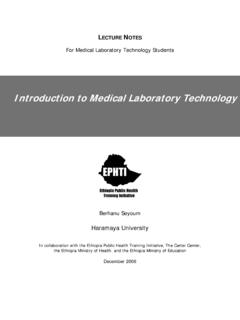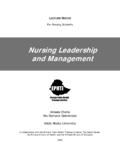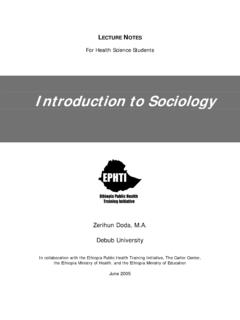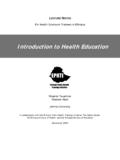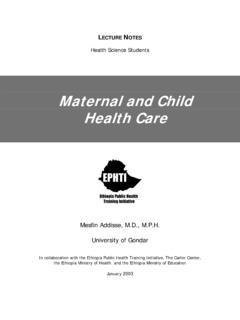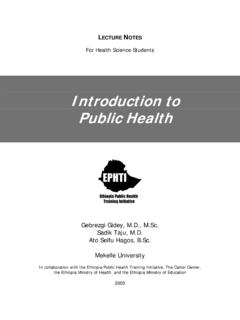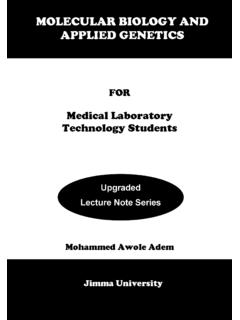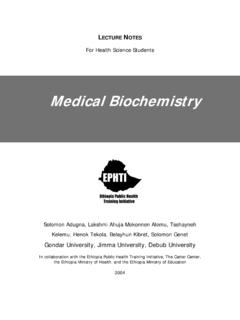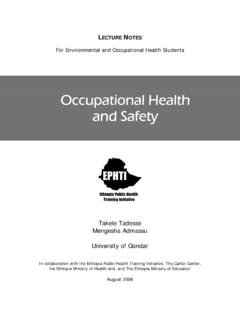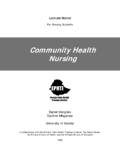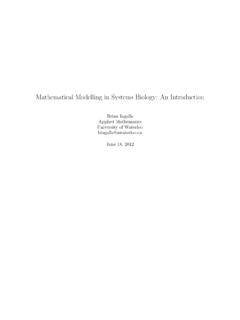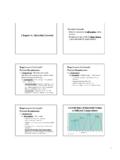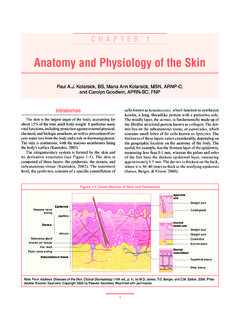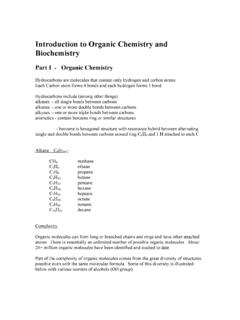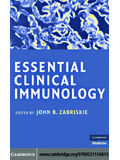Transcription of clinical nursing body - Carter Center
1 lecture notes For nursing Students Basic clinical nursing Skills Abraham Alano, , Hawassa University In collaboration with the Ethiopia Public Health Training Initiative, The Carter Center , the Ethiopia Ministry of Health, and the Ethiopia Ministry of Education Novermber 2002 Funded under USAID Cooperative Agreement No. 663-A-00-00-0358-00. Produced in collaboration with the Ethiopia Public Health Training Initiative, The Carter Center , the Ethiopia Ministry of Health, and the Ethiopia Ministry of Education. Important Guidelines for Printing and Photocopying Limited permission is granted free of charge to print or photocopy all pages of this publication for educational, not-for-profit use by health care workers, students or faculty. All copies must retain all author credits and copyright notices included in the original document. Under no circumstances is it permissible to sell or distribute on a commercial basis, or to claim authorship of, copies of material reproduced from this publication.
2 2002 by Abraham Alano, All rights reserved. Except as expressly provided above, no part of this publication may be reproduced or transmitted in any form or by any means, electronic or mechanical, including photocopying, recording, or by any information storage and retrieval system, without written permission of the author or authors. This material is intended for educational use only by practicing health care workers or students and faculty in a health care field iPREFACE nursing is core part in health service delivery system in which health promotion, disease prevention; curative and rehabilitative health strategies are applied. The clinical nursing skills for the nurses are of paramount important not only to provide comprehensive care but also enhance clinical competence. The purpose of preparing this lecture note is to equip nurses with basic clinical nursing skills, which will enable them to dispatch their responsibility as well as to develop uniformity among Ethiopian Professional Nurse Training Higher Institutions.
3 The lecture note series is designed to have two parts: part-I is composed of most basic clinical skills, where as part two will be covering most advances clinical skills as well as fundamental concepts related to the skills. It is well known that no nursing service can be provided with out basic clinical nursing skills. For nurse to provide health service at different settings; hospital, health Center , health post and at the community level including home based care for chronically sick patients, the course is very essential. It is also hoped that other primary and middle level health professional training institution will utilize the lecture notes to rational exercise the professional skills. The lecture note is therefore organized in logical manner that students can learn from simpler to the complex. It is divided in to units and chapters.
4 Important abbreviations and key terminologies iihave been included in order to facilitate teaching learning processes. On top of that learning objectives are clearly stated to indicate the required outcomes. Glossary is prepared at the end to give explanation for terminologies indicated as learning stimulants at beginning of each chapter following the learning objectives. Trial is made to give some scientific explanation for procedure and some relevant study questions are prepared to each chapter to aid students understand of the subject. To enhance systematic approach in conducting nursing care the nursing process is also indicated for most procedures. iiiACKNOWLEDGEMENT My deepest appreciation is to The Carter Center , EPHTI and Professor Dennis Carlson, senior consultant of the Center for his tireless efforts to materialize the issue of staff strengthening and curriculum development.
5 lecture note preparation is one of the activities that got due attention to strengthen the teaching learning process in Ethiopia by Ethiopian staff. There fore, I congratulate Professor Denis Carlson for the success you achieved with dedicated Ethiopian partners. I also extend many thanks to colleagues and staff of our School of nursing particularly Ato Andargachew Kassa and Ato Aweke Yilma for their valuable comments and criticism, other wise the lecture note would have not been shaped this way. I would like to extend my thanks to Ato Asrat Demissie Academic Vice President of Defence University College and Ato Daniel Mengistu Head of School of nursing in University of Gondar for their critical review and valuable comments. My sincere gratitude is also to the staff members of schools of nursing , sister Universities, (Ato Birara Tadeg, GU, Ato Getachew Worku, DUC, Sr.)
6 Netsanet Shiferaw, JU, Ato Tesfaye Abebe, HU) for their tireless and meticulous revision of the material otherwise difficulties would have faced to shape this way. ivSimilarly, my felt thanks is to supportive staff of The Carter Center EPHTI, Dr Hailu Yenenh, Ato Aklilu Mulugetta , W/rt Meseret Tsegaw and all other staff for their devoted support through the preparation of this lecture note. Next, I thank all our College authorities for permission to work on this lecture note besides the routine activities of the college. Last but not least, my deepest gratitude is to W/rt Lemlem Adebabay who has managed to write the document with in very urgency giving up her rest time and comfort. v TABLE OF CONTENTS Content Page Preface .. i Acknowledgement .. iii Table of v List of Figures .. xii Abbreviation .. xiii Unit One Chapter 1 .. 1 Introduction .. 1 Definition of nursing .
7 1 Historical background of nursing .. 2 History of nursing in Ethiopia .. 8 nursing process and Critical thinking .. 10 Unit Two Safety in Health Care facilities .. 18 Chapter 2: infection control/ universal precaution .. 18 nursing process 19 Normal body defense .. 22 Chain of infection .. 24 Basic medical asepsis .. 26 vi Hand washing .. 26 Standard precaution .. 29 Surgical 33 37 Chapter 3: Care of patient 49 The patient unit .. 50 Care of hospital and health care unit equipment .. 54 Unit Three Basic Client Care .. 58 Chapter 4: Admission, Transfer, and Discharge of client .. 58 Admission .. 59 61 62 Chapter 5: Vital Signs .. 66 Definition .. Temperature .. 69 Pulse .. 77 82 Blood 83 Chapter 6: Specimen collection .. 90 General consideration for specimen 91 Collecting stool specimen.
8 92 Collecting urine 94 Collecting sputum .. 99 Collecting blood 101 Chapter 7: Bed 109 Closed bed ..110 vii Occupied 110 Post operative 112 Chapter 8: Personal hygiene and skin 120 Mouth 120 125 Bed 128 Therapeutic bath .. 131 Back 134 Giving and receiving bedpan and urinals .. 138 Perineal 140 Hair 145 Pediculosis treatment .. 150 Chapter 9: Cold & heat application .. 158 Care of a patient with 158 Heat application .. 159 Cold application .. 160 Tepid sponge .. 160 Local application of cold and heat .. 161 Application of cold .. 161 Application of 163 Sitiz bath .. 164 Chapter 10: Body mechanics and mobility .. 167 Body mechanics .. 168 Basic principles of body 168 Turning the patient to a side lying position.
9 172 Joint mobility and range of motion .. 173 viii Body positioning .. 177 Guideline for positioning the 177 Client positioning for examination & treatment .. 179 Crutch walking .. 183 Application of nursing 183 Teaching technique for crutch walking .. 184 Teaching up stair and down stair walking with 189 Helping the client into wheel 190 Unit 194 Chapter 11 Nutrition and metabolism .. 194 Fluid and electrolyte balance .. 194 Acid base balance .. 200 208 Gastrostomy/jejunostomy feeding .. 211 Inserting a gastric tube .. 211 Nasogastric 217 Total parentral 221 Unit Five Chapter 12 Elimination of Gastro Intestinal and Urinary Tract Gastric Gastric aspiration.
10 234 ix Enema ..236 Cleansing enema ..237 Retention enema ..241 Rectal Passing flatus tube ..243 Urinary catheterization ..244 Catheterization using straight catheter ..246 Inserting indwelling Unit Six Chapter 13 Medication Administration ..252 Definition of Drug metabolism ..253 Factors affecting drug metabolism ..255 Drug administration ..256 Application of nursing process ..257 Oral drug administration ..259 Suppository ..263 Subcutaneous injection ..267 Intramuscular injection ..269 Intravenous injection ..273 x Intravenous Blood transfusion ..278 Cut down ..283 Administration of vaginal Administration of ophthalmic medication.
